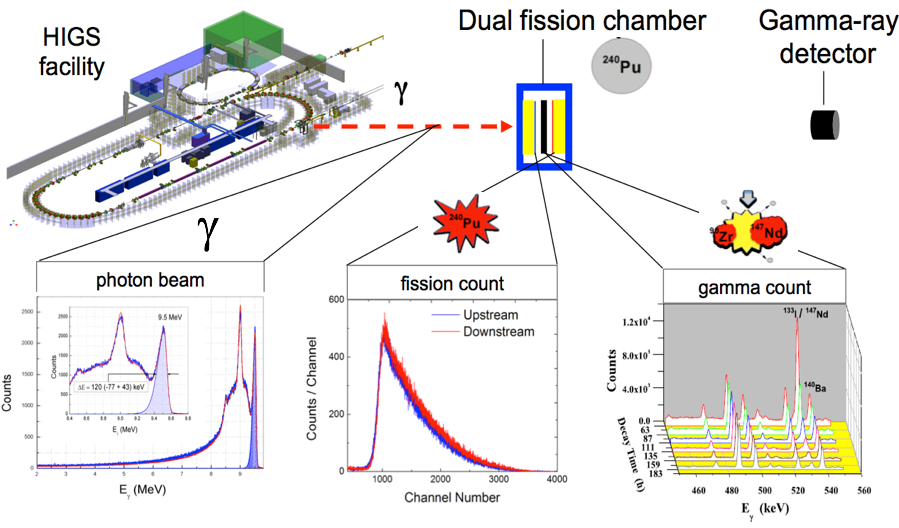Anton Tonchev (17-LW-020)
Executive Summary
Our experiment will compare, for the first time, fission product yields of the same plutonium-240 compound nucleus produced via two different reactions. Results will provide highly accurate experimental data for nuclear theory as well as benchmarks for the stockpile sciences' theoretical models to assess the predictability of nuclear fission simulations.Project Description
In 1939, physicists formulated a theory of neutron-induced nuclear fission based on the hypothesis of the compound nucleus. The “Bohr hypothesis,” still at the heart of every theoretical fission model, states that the decay of a compound nucleus for a given excitation energy, spin, and parity is independent of its formation. Although this hypothesis is widely accepted by both theorists and experimentalists, its implications, particularly concerning fission product yields, have never been experimentally verified to high precision (currently verified to about 20% accuracy for certain reactions). In previous verification attempts, the neutron-induced fission cross sections were compared to estimations based on surrogate reaction data using light ion particles inducing fission. Moreover, these estimations were obtained using a simplistic theoretical approach, not independent data. We plan to conduct the first experiment validating to 1 to 2% absolute uncertainties the practical consequences of the hypothesis during induced nuclear fission. We will compare fission product yields of the same plutonium-240 compound nucleus produced via two different reactions: one in which neutrons interact with plutonium-239 and another in which gamma rays interact with plutonium-240. By using monoenergetic photons, we will create an excited plutonium-240 target at different energies and compare the resulting yields with those obtained from neutron-induced fission on plutonium-239. We hope to extend fundamental knowledge of nuclear fission by providing highly accurate experimental data for nuclear theory using the two most important incident particles inducing fission: neutrons and photons.
We expect to obtain high-precision, energy-dependent fission product yields from the photo-fission of plutonium-240, with an absolute uncertainty of less than 2% over a broad range of photon energies. We are using the methodology developed in a previous collaboration, in which we measured the absolute yields of specific fission product yields (such as neodymium-147, molybdenum-99, and barium-140) from neutron-induced fission on plutonium-239. For this current project, the fission product yields of plutonium-240 will be measured and compared using both neutron and gamma absorption excitation mechanisms. The gamma excitation work will take place at the High Intensity Gamma-Ray facility at Triangle Universities Nuclear Laboratory, Duke University in Durham, North Carolina (see figure). Results will be compared with the measurements of fission product yield from the neutron-induced fission of plutonium-240, yielding a unique, high-quality benchmark for fission theory. We also expect to provide the first experimental validation of the Bohr hypothesis to 1 to 2% accuracy. Our high-precision photo-fission experiment provides a unique opportunity for the Laboratory’s computational science and engineering capabilities by working to firmly validate theoretical fission models with the most accurate fission yield information acquired so far, as well as enabling assessment of the accuracy of our simulations' predictions.
Mission Relevance
Our project addresses the NNSA goal of managing the nuclear weapons stockpile by extending understanding of the condition of the stockpile, and contributes to the Laboratory's nuclear, chemical, and isotopic science and technology core competency by providing state-of-the-art data that will shape equations relevant to nuclear theory. The results of our research will also address long-standing nuclear data needs for Livermore's stockpile stewardship mission focus area.
FY17 Accomplishments and Results
In FY17 we obtained highly-enriched plutonium-240 from Oak Ridge National Laboratory in Tennessee and fabricated one thick and two thin electroplated plutonium-240 targets for fission-product yield measurements at the High Intensity Gamma-Ray Source at Duke University.
Publications and Presentations
Silano, J. 2017a. "Modernizing the Fission Basis: Short Lived Fission Product Yield Measurements in 235, 238U & 239Pu." FIESTA Fission School & Workshop, Santa Fe, NM, Sep. 17-22, 2017. LLNL-PRES-738667.
———. 2017b. "Short Lived Fission Product Yield Measurements in 235, 238U & 239Pu." FIESTA Fission School & Workshop, Santa Fe, NM, Sep. 17-22, 2017. LLNL-POST-738557.
Tonchev, A. 2017a. "Exploratory Study of Fission Product Yield Determination from Photofission of Pu-239 at 11 MeV with Monoenergetic Photons." Physical Review C. 95:024608. doi: 10.1103/PhysRevC.95.024608. LLNL-JRNL-698599.
———. 2017b. "Photofission Cross-Section Ratio Measurement of 235U/238U Using Monoenergetic Photons in the Energy Range of 9.0–16.6 MeV." Nuclear Instruments and Methods in Physics Research Section A. 854:40–44. doi: 10.1016/j.nima.2017.02.043. LLNL-JRNL-737088.
———. 2017c. "Recent Results from Fission Product Yield Measurements." 6th International Conference on Fission and Properties of Neutron-Rich Nuclei (ICFN6), November 6-12, 2016, Sanibel Island, Florida. LLNL-PRES-687227.
———. 2017d. “Connecting Nuclear Structure to Steller Astrophysics.“ 16th International Symposium on Capture Gamma-Ray Spectroscopy and Related Topics, CGS16, Shanghai, China, September 18-22, 2017. LLNL-PRES-891944.
Tonchev, A., et al. 2017a. "Energy Evolution of the Fission-Product Yields from Neutron-Induced Fission of 235U, 238U, and 239Pu: An Unexpected Observation." Sixth International Conference on Fission and Properties of Neutron-Rich Nuclei, Sanibel, FL, 6–12, November 2016. LLNL-PROC-717402.
———. 2017b. "Modernizing the Fission Basis." Fall Meeting of the APS Division of Nuclear Physics, Vancouver, Canada, October 13-16, 2016. LLNL-PRES-704201.
   





